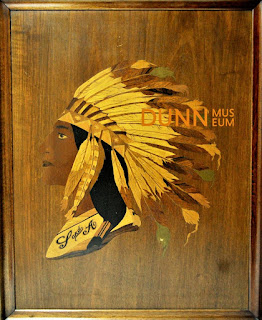Photo 1950s. Dunn Museum Collections.
Friday, December 17, 2021
Mary Louise Spoor Brand - Children's Book Illustrator
Photo 1950s. Dunn Museum Collections.
Thursday, June 17, 2021
From Cavalry to Tanks: George S. Patton Jr.
Tuesday, March 30, 2021
The Dairy Queen: Grace Garrett Durand
Durand was born in Burlington, Iowa to Martha Rorer and William Garrett. Grace’s ties to the Chicago area likely began with her brother’s marriage to Miss Ada Sawyer in 1884. Ada was the daughter of one Chicago's “pioneer druggists,” Dr. Sidney Sawyer.
In February 1888, Ada Sawyer Garrett and her mother, Elizabeth Sawyer, gave Grace an “elegant reception" at their home. This may have been Grace’s formal introduction to Chicago society. In the following years, Chicago’s Inter Ocean newspaper would note Dr. and Mrs. Sawyers’ travels with Miss Grace Garrett as their guest.
On news of her mother’s declining health, Grace returned home to Iowa to care for her. Martha Garrett died in February 1893.
In April 1894, Grace married wealthy sugar broker, Scott Sloan Durand of Lake Forest. Their wedding was held in Burlington, Iowa “in the presence of a brilliant assemblage of invited guests.” Grace’s maid of honor was the famous watercolor artist and illustrator, Maud Humphrey (1868-1940) of New York. Today, Maud is better known as the mother of Hollywood legend, Humphrey Bogart.
At the turn of the century, Durand shifted her focus to dairy farming as she became aware of infant mortality rates in Chicago linked to contaminated milk. Impure milk was a problem that had been combatted with varying success for centuries, but with the rapid growth of cities the problem was exacerbated. Inspired by her mother’s example of helping others, Grace saw a desperate need to provide clean milk to children.
In 1904, Durand established Crab Tree dairy farm on her Lake Forest property. However, her neighbors were not enamored of having a dairy herd in the neighborhood. Some complained of the “odor and flies” and that the herd’s “bawling” kept them awake at night.
An article in Pearson’s Magazine explained how Grace’s visit to Chicago's “tenement district revealed… most of the infant mortality was due to the want of nourishment, which meant good milk, and that good milk was a rare commodity, difficult to procure, even at exorbitant prices.” Durand used the profits from selling milk and thick cream to Chicago’s most select hotels, restaurants and tea rooms to support needy children.
Durand was known to pamper her cows and referred to them as her "pets." She enlisted the unusual method of playing opera music while the cows were milked. Grace claimed the music made the cows happy and consequently their milk tasted better and was more nutritious.
Dairy operations ceased when Grace Durand died on February 26, 1948. During her lifetime she was recognized as one of the “most powerful leaders in the milk crusade.”
Following Durand's death, William McCormick Blair (1884-1982) and his wife, Helen Bowen Blair (1890-1972), purchased Crab Tree Farm. The Blairs association with Durand had begun in 1926, with the purchase of 11-acres of the farm overlooking Lake Michigan.
Since 1985, Durand’s Crab Tree Farm has been owned by the John H. Bryan family. The property is still a working farm, and the original historic buildings have been renovated and now display collections of American and English Arts and Crafts furniture and decorative arts.
Special thanks to Laurie Stein, Curator at the History Center of Lake Forest-Lake Bluff, for additional research and enthusiasm for this topic.
- Diana Dretske ddretske@lcfpd.org
Wednesday, February 24, 2021
Private Henry McIntosh, 102nd U.S. Colored Troops
According to his family, McIntosh made his way via the secret network of abolitionists and safe houses known as the Underground Railroad. Many freedom seekers who headed north continued onto Canada, but McIntosh stopped in Detroit, Michigan where there was an established African American community.
Between August 1863 and February 1864, a total of 895 men from across Michigan signed the rolls for the new regiment. The unit received its commission into the service of the United States as the First Michigan Colored Infantry on February 17, 1864. Its' designation changed to the 102nd U.S. Colored Troops/Infantry (USCI) on May 23. Henry McIntosh served as a private in Company G.
Pressure from the governors prompted the War Department to muster-out the Black troops and send them home, essentially removing their presence from Southern states. The 102nd mustered-out September 30, 1865. They arrived in Detroit, Michigan on October 17 and received their final pay and discharge.
Shortly thereafter, Henry McIntosh made his way to Lake County, Illinois, seeking new opportunities, and settling in Lake Forest. One attraction to the area was the number of African Americans living there. This is likely where he met Sarah Martin, whom he married in 1869. According to the 1870 Census, there were eight African American households, totaling 30 people, in Shields Township/Lake Forest.
View of 1870 U.S. Census data for Henry McIntosh, misspelled "Mackintosh" and his wife Sarah. Ancestry.com.
Over one year later, on July 14, 1885, Henry married Fannie Davis Freleigh (1867-1960).
Son, Clarence Nathaniel McIntosh (1889-1963) served as Sergeant Major with the 351st Field Artillery during World War I; son, Wayman Hillis McIntosh (1900-1982), an athletic trainer at Lake Forest College, volunteered as air raid warden during World War II; grandson, Henry Nathaniel McIntosh (1923-1980) served as lieutenant in the U.S. Navy during the Korean War; and grandson Clarence Pearson McIntosh (1925-1999) served as a lieutenant in the U.S. Navy.









































